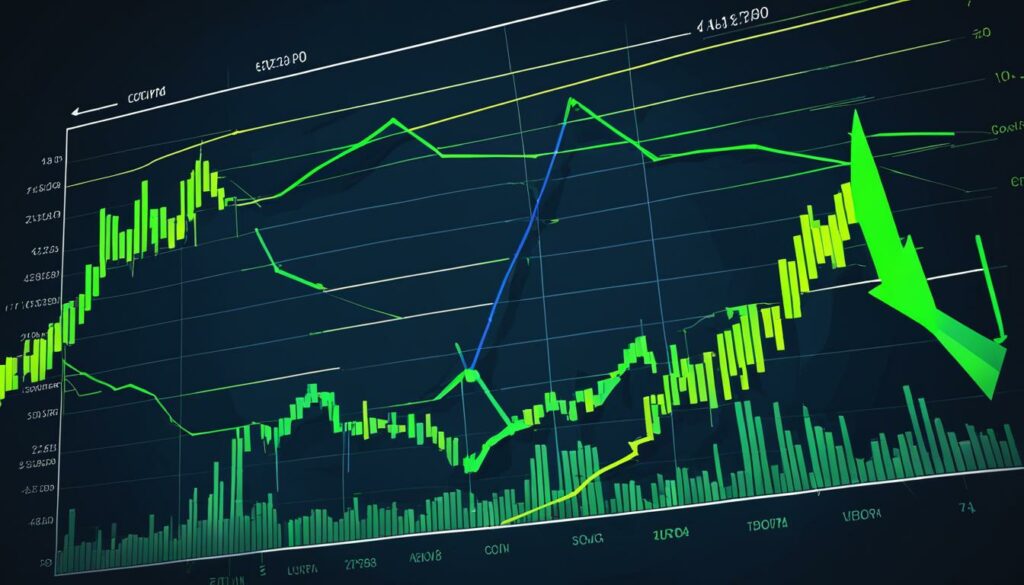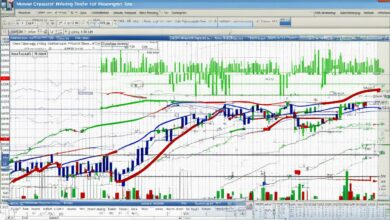Why Are Options Better Than Stocks?

Options trading has gained significant popularity among individual investors due to its unique advantages over traditional stock trading. In this article, we will explore the benefits of trading options instead of stocks, comparing the two and highlighting the advantages of options trading.
Key Takeaways:
- Options offer increased cost-efficiency compared to buying stocks outright.
- Options can provide reduced risk and downside protection for investors.
- There is potential for higher percentage returns with options trading.
- Options offer strategic alternatives and a wide range of investment strategies.
- Understanding the differences between options and stocks is essential for informed decision-making.
Understanding Options Trading
Options trading is a popular and versatile financial instrument that allows investors to take advantage of market movements and manage risk. To truly grasp the potential of options trading, it’s crucial to understand the key concepts and mechanics behind it.
Options Contracts: The Basics
At the core of options trading are contracts that give the buyer the right, but not the obligation, to buy or sell a specific amount of an underlying asset at a predetermined price, known as the strike price, on or before the expiration date. These contracts are known as options contracts.
Each options contract represents a specific number of shares of the underlying asset, such as stocks or commodities. The underlying asset can range from individual stocks to stock market indexes, currencies, or even futures contracts.
Options contracts come in two main types: call options and put options. A call option gives the buyer the right to buy the underlying asset, while a put option gives the buyer the right to sell the underlying asset.
Traders and investors can purchase options contracts from the options exchanges, where they are traded similarly to stocks. The price of an options contract, known as the premium, is influenced by factors such as the price of the underlying asset, time remaining until expiration, volatility, and market demand.
Hedging and Speculating
Options trading serves two primary purposes: hedging and speculating.
Hedging: Options can be used as a hedging tool to manage risk in a portfolio. By purchasing put options, investors can protect their investments against potential market downturns. If the market price of the underlying asset falls, the put options will increase in value, offsetting any losses in the portfolio.
Speculating: On the other hand, options can be used as a speculative tool to profit from market movements. Traders can purchase call options if they anticipate the price of the underlying asset to rise or put options if they expect the price to fall. If their predictions are correct, the options contracts can yield significant profits.
Flexible Strategies: Spread and Combinations
One of the major advantages of options trading is the ability to employ flexible and complex trading strategies. Traders can utilize various options strategies to align with their market outlook and risk tolerance.
Spread Strategies: Spread strategies involve simultaneously buying and selling options contracts with different strike prices or expiration dates. These strategies can limit risk and potentially enhance returns. Popular spread strategies include bull spreads, bear spreads, and butterfly spreads.
Combination Strategies: Combination strategies involve combining different options contracts to create customized positions. For example, traders can create a straddle position by simultaneously buying a call option and a put option with the same strike price and expiration date. This allows traders to profit regardless of whether the price of the underlying asset rises or falls, as long as there is significant movement in either direction.
By employing these flexible strategies, options traders have the ability to adapt to various market conditions and potentially generate profits irrespective of market direction.

Cost-Efficiency of Options Trading
Options trading offers a significant advantage in terms of cost-efficiency, thanks to its leveraging power. Compared to purchasing the underlying stock, investors can obtain option positions at a fraction of the cost. This cost-saving feature allows for greater leverage and more diversification in the investment portfolio.
One strategy that highlights the cost-efficiency of options trading is stock replacement. This strategy involves replacing the purchase of stocks with the purchase of call options. Let’s consider an example scenario:
Instead of purchasing 200 shares of an $80 stock for $16,000, investors can purchase two $20 call options for a total cost of $4,000.
By opting for this strategy, investors can achieve the same exposure to the stock market while saving a significant amount of capital. The leveraging power of options trading allows for a more cost-effective approach, making it an attractive choice for many investors.

| Investment | Number of Shares/Options | Price per Share/Option | Total Cost |
|---|---|---|---|
| Stocks | 200 | $80 | $16,000 |
| Options | 2 | $20 | $4,000 |
The cost-efficiency of options trading not only provides investors with potential savings, but it also offers the opportunity for greater flexibility and risk management in their investment strategies.
Reduced Risk with Options Trading
Options trading offers a unique advantage over traditional stock trading by providing reduced risk through various risk management techniques such as hedging and downside protection. Unlike stocks, options allow investors to set a definitive floor for potential losses, providing a level of certainty and control. Let’s explore how options trading can help mitigate risk in investment portfolios.
Hedging
One of the key risk management strategies in options trading is hedging. Hedging involves taking positions in options contracts that offset potential losses in other investments, such as stocks. By creating a balance between long and short options positions, investors can protect their portfolios against adverse market movements. This allows for a more diversified and resilient investment approach, reducing the overall risk exposure.
“Hedging is like buying insurance for your portfolio. It helps protect against unexpected market downturns and minimizes potential losses,” says Sarah Johnson, a seasoned options trader.
Stop-Loss Orders
While stop-loss orders are commonly used to protect stock positions, they can have drawbacks, such as the risk of being triggered by market volatility or gap openings. In contrast, options provide a more effective form of downside protection. For example, buying a put option allows the investor to sell the underlying stock at a predetermined price regardless of how low the market price drops. This ensures that potential losses are limited and provides peace of mind even during turbulent market conditions.
Example Scenario
To illustrate the reduced risk potential of options trading, let’s consider an example scenario. John, an investor, purchases 100 shares of XYZ Company stock at $50 per share. Concerned about potential market volatility, he decides to hedge his position by buying a put option with a strike price of $45. This put option gives John the right to sell his XYZ Company stock at $45 per share, protecting him from any significant downside in case the stock price declines.
Suppose the stock price of XYZ Company drops to $40 per share. In this scenario, John’s put option comes into play, allowing him to sell his shares at the predetermined price of $45, mitigating the losses he would have incurred without the protective option. This demonstrates how options trading can provide downside protection and reduce the risk of larger-than-expected losses.
By incorporating options trading strategies into their investment portfolios, investors can effectively manage risk and protect their wealth. Whether it’s through hedging or implementing stop-loss orders, options trading offers a range of tools to reduce risk and provide investors with greater peace of mind.
Higher Potential Returns with Options Trading
Options trading offers investors the potential for higher percentage returns compared to traditional stock trading. This is primarily due to the leverage effect that options provide. When investors buy an option, they are paying for the right, but not the obligation, to buy or sell an asset at a specific price within a certain time frame.
This leverage effect allows investors to control a larger amount of the underlying asset with a relatively small investment. For example, let’s consider a scenario where a stock experiences a significant price increase. In this case, the value of a call option can increase several times over, resulting in a substantial return relative to the initial cost of the option.
Options enable investors to amplify their potential returns by leveraging their investment, making it an attractive choice for those seeking higher profits. However, it’s important to note that along with the potential for higher returns, options trading also carries its own set of risks and complexities that investors should be aware of.
Now, let’s take a look at an example scenario to better understand the higher potential returns offered by options trading:

| Stock XYZ | Call Option on Stock XYZ |
|---|---|
| Purchase Price: $50 | Purchase Price of Option: $2 |
| Number of Shares: 100 | Number of Option Contracts: 10 |
| Selling Price: $80 | Selling Price of Option: $10 |
| Profit: $3,000 | Profit: $8,000 |
| Percentage Return: 60% | Percentage Return: 400% |
In this example, an investor purchases 100 shares of stock XYZ at $50 per share, resulting in a total investment of $5,000. If the stock price increases to $80 per share, the investor’s profit would be $3,000, representing a percentage return of 60%.
Alternatively, if the investor purchases 10 call options on stock XYZ at $2 per option contract, the total investment would be $200. If the stock price increases to $80 per share, the value of the call option would increase to $10, resulting in a profit of $8,000 and a percentage return of 400%.
This example demonstrates the potential for significantly higher returns with options trading compared to traditional stock trading. However, it’s important to note that options trading involves risks and may not always result in profits. It requires a thorough understanding of options and the underlying market conditions before making investment decisions.
Strategic Alternatives with Options Trading
One major advantage of options trading is the availability of strategic alternatives. Options are a flexible tool that allows investors to recreate other investment positions, known as synthetic positions, which can be useful for risk management and achieving specific investment goals. Options offer versatility and a wide range of strategies, providing investors with more options for their portfolio. Whether it’s using options for insurance, leverage, or more complex trading strategies, investors can benefit from the strategic alternatives offered by options trading.
Investors can create synthetic positions by combining multiple options contracts to mimic the behavior of another investment. This allows them to achieve similar results without actually owning the underlying asset. Synthetic positions can offer unique investment alternatives that may not be available through traditional stocks or other financial instruments.
One example of a synthetic position is the synthetic long stock, which involves combining a long call option and a short put option with the same strike price and expiration date. This position simulates owning stock while limiting risk and conserving capital.
Options’ versatility extends beyond creating synthetic positions. Investors can employ options trading for a variety of purposes, such as hedging against potential losses, generating income through options selling, or executing more complex trading strategies like spreads and combinations.

| Investment Alternatives | Risk Management | Versatility |
|---|---|---|
| Options provide alternative investment opportunities beyond traditional stocks. | Options can be used to hedge against potential losses and manage risk. | Options offer a wide range of strategies and approaches to suit different market conditions. |
Differences Between Options and Stocks
When it comes to investing, understanding the differences between options and stocks is crucial. While stocks represent ownership in individual companies and rise or fall based on the profitability of the business, options function as contracts between investors.
Options allow investors to bet on the direction of a stock’s price without owning the underlying shares. This key distinction sets options apart from stocks and opens up a different set of opportunities and risks for investors.
Here are some of the key differences between options and stocks:
1. Ownership vs. Contracts
Stocks provide ownership in a company, with shareholders entitled to voting rights and potential dividends. On the other hand, options are purely contractual agreements that grant the holder the right to buy or sell shares at a predetermined price within a specified timeframe.
2. Volatility
Stocks are exposed to market volatility and can experience substantial price fluctuations based on various factors such as economic conditions, industry trends, and company-specific news. Options, on the other hand, are influenced not only by the underlying stock’s price movement but also by volatility measures.
3. Lifespan
Stocks have an indefinite lifespan and can continue to exist as long as the company remains in operation. In contrast, options have a fixed lifespan and come with expiration dates. These expiration dates limit the timeframe within which options can be exercised, adding an element of time sensitivity to options trading.
4. Types of Options
Options come in two major varieties: call options and put options. Call options give the holder the right to buy shares at a predetermined price (the strike price) within a specific timeframe. Put options, on the other hand, provide the holder with the right to sell shares at the strike price within the specified timeframe.
| Aspect | Stocks | Options |
|---|---|---|
| Ownership | Own company shares | Contractual agreement |
| Volatility | Exposed to market volatility | Influenced by underlying stock’s price and volatility |
| Lifespan | Indefinite | Fixed with expiration dates |
| Types | N/A | Call options and put options |
Understanding the differences between options and stocks is essential for investors looking to diversify their portfolios and explore different investment strategies. Both options and stocks have their advantages and risks, and investors should carefully consider their investment goals and risk tolerance before diving into either market.

Pros and Cons of Stocks
When it comes to investing, stocks have their own set of advantages and disadvantages. Understanding the pros and cons can help investors make informed decisions based on their individual financial goals and risk tolerance.
Pros of Stocks
- Potential Returns: Investing in stocks provides the potential for high returns over the long term. As companies grow and succeed, their stock prices may increase, allowing investors to profit from capital appreciation.
- Dividends: Some stocks pay dividends, which are regular distributions of a company’s profits to its shareholders. Dividends can be a source of passive income, providing investors with a steady cash flow.
- Acquisition Opportunities: Owning stocks allows investors to participate in company acquisitions and mergers. If a company gets acquired at a premium, stockholders may benefit from the increase in stock price.
- Relative Simplicity: Investing in individual stocks is relatively straightforward compared to other investment vehicles. Investors can research and choose companies that align with their investment strategies and interests.
Cons of Stocks
- Risk: Stocks come with the inherent risk of price volatility. The stock market can experience fluctuations due to various factors, such as economic conditions and market sentiment. Prices can rise and fall rapidly, leading to potential losses.
- Potential Losses: Investing in stocks carries the risk of losing all or most of your investment if a company fails or performs poorly. Individual stocks can be affected by company-specific events, industry trends, or broader market conditions.
| Pros of Stocks | Cons of Stocks |
|---|---|
|
|
Before investing in stocks, it’s essential to carefully consider your own financial situation, investment objectives, and risk tolerance. A diversified portfolio that combines stocks with other asset classes can help mitigate risk and maximize potential returns.

Pros and Cons of Options
Options trading offers several advantages for investors seeking high returns and flexibility in their trading activities. One of the major benefits of options is the potential for high returns. Due to the leverage effect, options allow investors to control a larger amount of the underlying asset with a relatively small investment. This can result in significant returns compared to the initial cost of the option.
Moreover, options provide the flexibility to tailor trades to specific timing and market conditions. With options, investors have the ability to capitalize on short-term price movements and execute strategies that align with their investment goals. This flexibility allows for more precise risk management and the potential to profit under diverse market scenarios.
However, it’s important to note that options trading requires a more hands-on approach and a deeper understanding of the market. Unlike stocks, where investors can take a more passive role, options trading demands active monitoring and decision-making. This active involvement can be both exhilarating for those who enjoy a hands-on approach to investing and challenging for those who prefer a more passive investment style.
Additionally, options trading can incur higher costs compared to stock trading. These costs include commissions, fees, and the potential for losses if options expire worthless. Before engaging in options trading, investors should carefully consider these costs and ensure they have a comprehensive understanding of the strategies they are employing to minimize potential risks.







